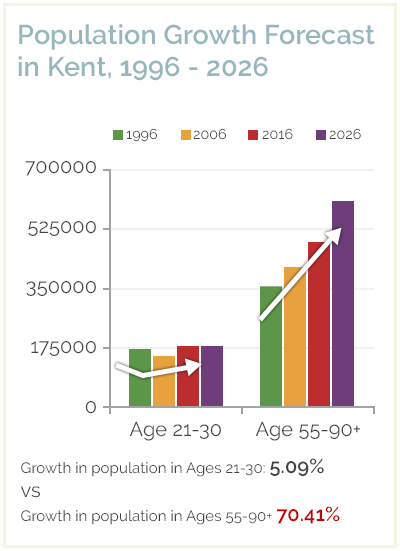The Case for Retirement Living
Provision of retirement communities and projected demand.
Over 11.4 million homeowners are aged 55 or over. Although almost a third of older homeowners considered downsizing in the last 5 years only 7% actually did.

They are sitting on £820 billion of property wealth and 7.7 million spare bedrooms. This represents 10 years of housing supply based on Government targets – or 20 years based on current housing completions. They could hold the key to alleviating the challenges faced across the property chain by freeing up housing for growing families.
However, the UK suffers from a chronic undersupply of age-specific housing. Under 3% of the England’s housing stock is retirement property, housing just 1% of 15 million people in their 60’s (compared with 17% in the USA).
Only 3% of new housing which has been granted planning permission is specifically for ‘elderly’ or ‘sheltered’ accommodation. This suggests around 5,500 retirement housing units are being delivered a year based on the current planning to development ratio.
Once levels of home ownership and desire to move are taken into account, data suggests potential demand for 30,000 units per year.
Yet Retirement Living falls between two parts of the planning system – it is either standard market housing despite the specialised nature or C2 Institution / Care home where residents must pay for expensive care, whether they need it or not. Whilst some boroughs are now recognising the need for retirement housing in their plans it is often difficult to demonstrate that need unless mandatory care is attached.
Also, certain developments have experienced very high ground rents and charges and have suffered poor resale values as a result.
What is needed is more clusters of bungalows in villages, and ground rent free apartments on the edge of towns. Onsite managers but no event fee clauses in leases. Management that is not run as a profit centre.
(Information taken from the Last Time Buyers Report by Legal & General (2015), in conjunction with the Centre for Economics and Business Research (CEBR), and from the Knight Frank Properties Report (2016).)
Population growth in Kent
From 2005 to 2015 the population of Kent has grown by 10.9%. It is forecast to increase by a further 21.6% by 2035. Significantly, the growth is largest in the over 55 age group, a trend which is forecast to continue. In contrast, population growth in the 21-30 age group (first time buyers) is forecast to stagnate and may even drop.
Data from kent.gov.uk